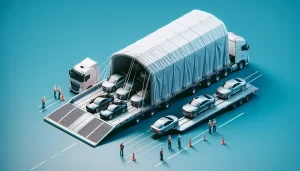Introduction to Auto Transport Cost
When you need to move a car from one place to another, auto transport becomes your go-to solution. But, let’s not beat around the bush, it costs money. Understanding these costs is vital. The price to transport a vehicle can vary widely. It depends on several factors like the distance, type of transport, and size of your vehicle. For a rough idea, shipping a car within the US can range from (500 to )1,500. Longer distances and bigger cars up the price. You’ve got options: open transport is cheaper, while enclosed transport protects your car but hits your wallet harder. The timing matters too. Need it moved yesterday? That’ll cost extra. In a nutshell, auto transport doesn’t have a one-size-fits-all price. It’s about what you need, where you’re going, and how fast you want to get there.
Key Factors Influencing Auto Transport Cost
When you need to ship a car, several things will decide how much you’re going to pay. First off, the distance your car needs to travel is a big deal. Longer trips mean higher costs. Then, there’s the type of transport you choose. Open carriers are usually cheaper than enclosed ones. Enclosed carriers protect your car better, but you’ll pay extra for that security. Also, the size and weight of your car matter. Bigger, heavier cars take up more space and cost more to move. The time of year can also change the price. Shipping during busy times, like summer or right before Christmas, might cost you more because everyone wants to move their cars then. Lastly, how fast you need your car to be delivered plays a role. If you’re in a rush, you’ll likely have to pay more for expedited service. So, when planning to transport your car, think about these factors. Each one adds up, shaping the final cost of shipping your vehicle.
How Distance Affects Pricing in Auto Transport
Distance plays a big role in how much you’ll pay for auto transport. Think about it this way; the farther your car needs to travel, the more it’s going to cost you. If you’re moving a car across the country, expect to pay more than if you’re just sending it a few states over. This is because the transport company has to cover more fuel, more hours on the road, and higher wear and tear on their trucks. Generally, you’ll find that prices can start as low as $0.40 per mile for long distances. However, for shorter moves, let’s say less than 500 miles, the price can spike to $1.00 per mile or more. It’s all about efficiency; longer trips spread the costs over more miles, making each mile cheaper. Remember, though, these are just ballpark figures. The final price can change based on other factors like gas prices, the time of year, and the demand for transport services.
The Impact of Vehicle Type and Size on Cost
When you’re moving a car, the kind of vehicle you have makes a big difference in how much you’ll pay. Smaller cars are cheaper to move. Think sedans or compact cars. They take up less space and are lighter, which means the transport truck can carry more of them at once. This lowers the cost for you. On the other hand, big vehicles like SUVs or trucks cost more. They’re heavier and take up more space on the transport truck, limiting how many vehicles can be transported simultaneously. Plus, because they’re heavier, the truck uses more fuel, which increases the cost further. So, when you’re looking at auto transport prices, remember that your vehicle’s type and size will be a big factor in the final cost.
Seasonal Variations in Auto Transport Pricing
Just like the seasons change, so does the cost to move your car. Summer months see prices climb – that’s when everyone wants to ship their cars, especially families moving before the new school year begins. But, winter is a different story. Fewer people are looking to transport their vehicles, which means prices tend to dip. However, don’t forget about snowbirds – retirees who move south for the winter. Their movement can keep prices from dropping too low in certain routes. So, remember, timing is everything. Plan your auto transport in the off-season, and you might just nab a better deal. But, stay flexible; prices can fluctuate based on demand, weather, and fuel costs.
Enclosed vs. Open Transport: Cost Differences
When moving your car across the country or even just a state away, you’ll face a choice between enclosed or open transport. Here’s the scoop: open transport means your car will be on an open trailer, exposed to the elements. It’s the cheaper option. On average, open transport can cost you about (0.40 to )0.60 per mile. It’s popular and widely available, which helps keep prices competitive.
Now, enclosed transport is like first-class for your car. It’ll be inside a covered trailer, safe from weather and road debris. However, this premium service comes with a higher price tag, typically (0.60 to )1.00 per mile. It’s the go-to for luxury or classic cars that need extra protection.
In short, if you’re tight on budget or have a car that can weather the journey, open transport is your ally. But if you’ve got a car you treasure or are moving it through harsh weather conditions, enclosed transport might be worth the extra bucks. Keep in mind, the longer the distance, the more the cost difference between the two options will matter.
Insurance and Additional Services: Adding to the Base Price
When you ship a car, the base price isn’t the whole story. Think of it like buying a plane ticket, but for your car. Just like you pay extra for a better seat or to check a bag, moving cars comes with options too. First, there’s insurance. Most times, the basic insurance is in the deal, but it might not cover everything. If you’re shipping a fancy or expensive car, you’ll want to think about getting more insurance. This extra coverage ensures you’re not out of pocket if something goes wrong. Then, there are additional services. Want your car to be the first off the truck, or need it picked up from a specific spot? That’s going to cost more. It’s like adding extra toppings to a pizza; the more you add, the pricier it gets. Remember, these extras can really change how much you pay in the end. So, think about what you need and what you can skip.
How to Get Accurate Quotes for Auto Transport
To get accurate quotes for auto transport, you’ll want to do your homework. Start by collecting details about your vehicle, like make, model, and year, since this information impacts the cost. You’ll also need to decide if you want open or enclosed transport. Open transport is cheaper, but enclosed provides more protection for your car. Be clear about pickup and delivery locations. Prices can vary significantly based on how easy it is to access these points. Finally, check the timing. If you’re flexible with your dates, you might snag a better deal. Always ask for quotes from multiple companies to compare prices. Don’t forget, the cheapest option isn’t always the best. Check reviews to ensure you’re picking a reliable service. This way, you won’t be caught off guard by hidden fees or surprises.
Tips for Saving Money on Auto Transport
Shipping your car doesn’t have to break the bank. There are several ways you can save money on auto transport. First, book early. Transport companies often offer lower rates for advanced bookings. This allows them to plan their routes more efficiently, passing the savings on to you. Second, be flexible with your shipping dates. Prices can vary depending on the season. Summer and just before the winter holidays are peak times and tend to be pricier. Ship your car during off-peak seasons, if possible, to save. Third, choose open transport over enclosed transport. Open transport is significantly cheaper. While it exposes your car to the elements, it’s still a safe option for most vehicles. Fourth, consider terminal-to-terminal shipping. Although less convenient than door-to-door service, it can reduce your costs. You’ll need to drop off and pick up your car at these transport terminals, but the savings might be worth the extra effort. Lastly, gather quotes from different companies and negotiate. Prices are not set in stone, and companies might match or beat competitors’ quotes. Keep these tips in mind, and you can save a chunk of change on your auto transport needs.
Summary: Navigating Auto Transport Economics Wisely
Understanding the economics of auto transport is about making smart choices that save you money while ensuring your vehicle gets from A to B safely. Let’s face it, moving a car isn’t cheap, but knowing the ropes can help you avoid paying more than you need to. First off, the type of transport you choose matters. Open carriers are the budget-friendly option, usually costing less but leaving your car exposed to the elements. Enclosed carriers, on the other hand, offer top-notch protection for your ride at a higher price. Then there’s the timing. Prices can soar during peak moving seasons or when you’re in a rush. Planning ahead can cut costs significantly. Also, the distance plays a big role; longer trips mean higher prices, but the cost per mile drops as the distance increases. Lastly, where you’re shipping to and from impacts the price. Remote locations might cost you more due to the extra work involved in getting there. In short, a mix of smart choices and flexibility can make a big difference in the economics of auto transport.




